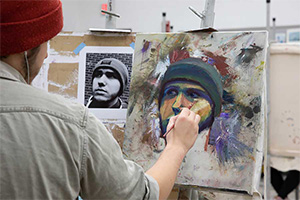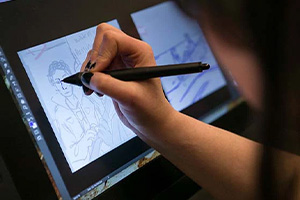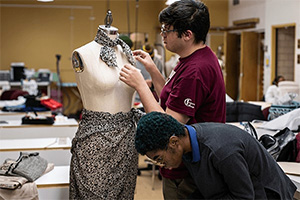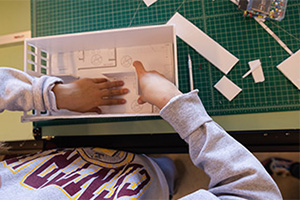Art majors and 20 careers after graduation
The next time you're walking through town, driving through a city or inside a store, take a moment to look around. You'll notice that nearly everything around you has been shaped by designers. From billboards and street signs to product packaging and clothing, design is part of almost every aspect of what we see, use and experience.
But how do you start a career in art and design? Your best bet is to start gaining experience and exploring your options as early as possible. You’ll discover what art majors study in school, careers you can choose from after graduation and how much those careers make.
From design to history and digital productions, discover what art looks like at Central Michigan University.
What art majors study in college
An art major builds on existing skills, acts on creativity and expands students’ knowledge of art and design. Students will choose from several subject areas while studying fine arts.
In your art major, you'll study within four main areas: art history and criticism, studio art, digital media and product design.
Art history, theory and criticism
Studying great collections of art helps students develop a critical eye and appreciate diverse styles and techniques that have travelled around the world. It also strengthens their ability to communicate ideas and have meaningful conversations about art.
 Art history: Explore how art has evolved across cultures and history to reflect societal changes and values. Learn about key art styles, famous artists and works that shaped creativity.
Art history: Explore how art has evolved across cultures and history to reflect societal changes and values. Learn about key art styles, famous artists and works that shaped creativity.
Art theory and criticism: Dive into the philosophies that link art to culture, politics and society. You’ll learn how to analyze and critique art insightfully, and how to effectively communicate your ideas with your peers.
Studio art
Students gain valuable firsthand experience creating and refining their work in lab or studio settings. Fine arts classes emphasize technique, experimentation and encourage self-expression. Using space and resources, students will prepare professional-grade work to showcase to potential employers, clients and graduate school admissions.

Drawing and painting: Learn essential drawing and painting skills, from line, composition and color theory. Experiment with techniques of graphite, charcoal, watercolor, oil and acrylic.
Sculpture and ceramics: Craft materials such as clay, metal and wood to create forms that convey your ideas and emotions. Master a variety of techniques, including carving, molding, assembling, wheel-throwing, glazing and surface decoration.
Digital media
The study of digital media provides highly relevant skills in today's tech-driven world. Digital media allows students to explore innovative techniques, experiment with new tools and create artwork that can be easily shared and distributed globally.
 Graphic design: Explore typography, layout, branding and storytelling to create impactful designs for print and digital platforms. You'll work worth software popular in the industry, like Adobe Photoshop, Illustrator and InDesign.
Graphic design: Explore typography, layout, branding and storytelling to create impactful designs for print and digital platforms. You'll work worth software popular in the industry, like Adobe Photoshop, Illustrator and InDesign.
Photography: Learn to capture stunning images by applying the principles of composition, lighting and editing. Sports photography and photojournalism are popular options.
 Animation: Master motion design, character creation and storytelling to bring visuals to life. Use tools like Blender and Adobe After Effects to understand timing, movement and narrative while creating your own animations.
Animation: Master motion design, character creation and storytelling to bring visuals to life. Use tools like Blender and Adobe After Effects to understand timing, movement and narrative while creating your own animations.
Film production: From scriptwriting and scene design to production and post-production, film students study every piece that goes into telling a story through videos. Learn to analyze films, act on feedback and steer the product to meet the director's creative vision.
Product design
Art students learn the skills to create functional and visually pleasing objects that solve real-world problems when they study product design. This subject area prepares a solid base for prototyping, material selection and design thinking. This is where artists can practice merging expression with practical application.
 Fashion Design: Learn to apply design principles, forecast trends and craft unique collections that stand out. Gain hands-on experience with pattern-making and garment construction, while also exploring digital tools like Adobe Illustrator for creating professional sketches.
Fashion Design: Learn to apply design principles, forecast trends and craft unique collections that stand out. Gain hands-on experience with pattern-making and garment construction, while also exploring digital tools like Adobe Illustrator for creating professional sketches.
Interior Design: Dive into the world of interior design by mastering space planning, color theory and material selection to create stunning, accessible and highly functional spaces. Gain hands-on experience with software like AutoCAD, 3ds Max and SketchUp.
Job market trends in the creative industry
According to the U.S. Bureau of Labor Statistics (BLS), the creative industry is on par with the expected average growth for all occupations from 2023 to 2033 (Arts and Design Occupations, U.S. Bureau of Labor Statistics). Employers are expected to create an average of 87,900 job openings each year. In May 2023, the median annual wage for this group was $51,660, higher than the overall median wage of $48,060 (BLS).
Digital skills are becoming increasingly critical, as employers seek professionals proficient in areas such as graphic design, animation, web development and social media marketing. For instance, the BLS reports that demand for web developers and digital designers is expected to grow 8% in the same period, faster than the average for all occupations (Web Developers and Digital Designers, BLS).
Careers that require artistic skill
One of the biggest misconceptions about art majors is that career opportunities are limited. The truth? Art majors have limitless choices! Creativity paired with strong technical skills makes art graduates highly employable in a variety of industries.
Here are some ideas for creative paths, commercial or technical roles and other opportunities open to art majors.
Creative career paths:
- Graphic Designer or Desktop Publisher: $58,910
- Illustrator: Projected salary of $52,910
- Animator/Multimedia Designer: $99,060
- Photographer: $40,760
- Special Effects Artist or Animator: $98,950
- Film and Video Editor: $63,520
- Audio/Visual Technician: $54,160
- Fashion Designer: $62,530
- Interior Designer: $62,510
Commercial and technical roles:
- Web and Digital Interface UI/UX Designer: $98,540
- Digital Marketing Specialist: $52,761
- Digital Designer: $83,240
- Industrial Designer: $75,910
- Product Development Engineer: $78,627
More opportunities:
- Set and Exhibit Designer: $59,490
- Stage Makeup Artist: $93,850
- Curator/Museum Director: $57,120
- Museum Technician or Conservator: $47,270
- Event Planner: $56,920
- Art Director: Projected salary of $106,500
Art majors can even pursue entrepreneurial paths, launching their own businesses as freelance designers, artists or consultants. Combining creativity with entrepreneurial skills has helped many art majors succeed as business owners. These skills are essential for bringing diverse projects to life with impact and creativity.
Diverse career paths for art majors
Creative people often find it particularly difficult to choose a field of study when they have several different areas of interest. Luckily, the field of art has connections and outlets everywhere!
Majoring in art means developing essential skills like critical thinking, problem-solving and visual communication—abilities valued across many industries. Art majors learn to combine storytelling, innovation and design principles to create ideas that resonate with audiences. These skills are crucial in fields like marketing, technology, education, entertainment and more.
You may choose to pair an art major with another field of study by double majoring or choosing to major in another field while pursuing an art minor. For example, combining art with a business degree may be perfect for careers like brand management or entrepreneurship. Combining art and technology, like computer science, can open doors to careers in UX design, animation or game development. It’s where creativity and technical skills come together.
Similarly, students majoring in science, engineering or healthcare can benefit from adding an art minor. It can spark fresh perspectives and encourage innovative thinking.
 Careers such as medical visualization or architectural design rely on both technical knowledge and artistic skills to communicate complex ideas visually.
Careers such as medical visualization or architectural design rely on both technical knowledge and artistic skills to communicate complex ideas visually.
In today’s visually-driven world, art and design are more important than ever. Students stand out in a competitive job market when they apply their technical expertise and artistic innovation.
Start your journey into art and design
Pursuing an art major unlocks a world of creativity and professional possibilities. Whether you dream of becoming an animator, designer or curator—or something entirely unique—studying the fine arts provides a foundation to bring your dreams to life.
Central Michigan University offers four Art and Design Majors:
and more options in their School of Communication, Journalism and Media!
Explore your interests, refine your talent and build a career that rises to our world's creative challenges. The world of art is waiting—so, what are you waiting for?
Check out what some of our alumni are up to:
Department of Art and Design Alumni SCJM Alumni
Sources
- MyMajors.com, Art Major: https://www.mymajors.com/college-majors/art/
- U.S. Bureau of Labor Statistics: https://www.bls.gov/